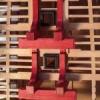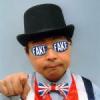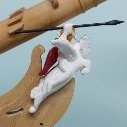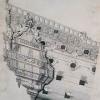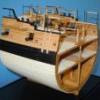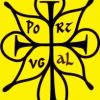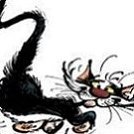MORE HANDBOOKS ARE ON THEIR WAY! We will let you know when they get here.
×
-
Posts
1,644 -
Joined
-
Last visited
Reputation Activity
-
 SJSoane got a reaction from Mike Y in HMS Bellona 1760 by SJSoane - Scale 1:64 - English 74-gun - as designed
SJSoane got a reaction from Mike Y in HMS Bellona 1760 by SJSoane - Scale 1:64 - English 74-gun - as designed
A small update on the traiboard question. In posting 2286 above, I showed the two different trailboards for the two different Bellona models. I wanted to follow the first model because it is closer to the original design (since it predates the second model by 20 years or so), but the only photo I have is frustratingly out of focus.
I also looks like it lost parts in the center, and I could not imagine how to recreate the original design.
Then I saw the trailboard for a contemporary ship, HMS Hercules or Thunderer, launched just one year before the Bellona, in 1759. This shows a floral scroll:
So I traced what I could see of the remaining Bellona pieces, and speculated on how it might have been filled in in the spirit of the Hercules design. Too far down the road of speculation? At least it would be easier to make than the second Bellona model design, with its super thin spears, the George III cypher, etc.
-
 SJSoane got a reaction from noel_colledge in HMS Bellona 1760 by SJSoane - Scale 1:64 - English 74-gun - as designed
SJSoane got a reaction from noel_colledge in HMS Bellona 1760 by SJSoane - Scale 1:64 - English 74-gun - as designed
Hi Noel,
Others more experience than I may have a better answer, but so far, I have used this trick for temporarily holding other parts together (for example, to shape a port and starboard piece at the same time for perfect symmetry), and I have had no problems with distorting or discoloring the wood. Using 99% isopropyl means it is mostly alcohol, and it dries quickly when the piece is removed from the bath.
My biggest mistake was using too much glue. Only a tiny drop or two will temporarily hold parts together, and this is much faster to release than a full coating of glue. Indeed, I have given up trying to separate pieces that were glued too thoroughly together.
Best wishes,
Mark
-
 SJSoane got a reaction from GrandpaPhil in HMS Bellona 1760 by SJSoane - Scale 1:64 - English 74-gun - as designed
SJSoane got a reaction from GrandpaPhil in HMS Bellona 1760 by SJSoane - Scale 1:64 - English 74-gun - as designed
I finally made my first foray into miniature carving. I started with the lion heads on the outboard ends of the cat beams. 7.85 mm or 5/8 inch square, so tiny enough to keep me focused!
I used my Russian chisels for the first time. They are as wonderful as everyone says. Super sharp, well balanced, controllable cuts.
I glued 3000 grit paper to a hardwood block for sharpening. I have been able to sharpen freehand with success, using the fore and middle fingers to hold the chisel at the right angle to the block, and the fore finger to press slightly down on the cutting edge. It brings back the super sharp edge in only a few strokes. And it does have to be touched up regularly, like every 8-10 cuts. I haven't had to do the gouges yet. That looks more challenging, especially the .5 mm one.
At first, I took chisels out and put them on my desk when switching to another chisel. I quickly found out that this does not work. First, they were all to easily starting to roll towards the front edge of my bench when I wasn't looking. Second, the cutting edges are so tiny that I would have to pick up each on on my bench to look very carefully to find the right one. I decided it was a better idea to keep them in their box whenever not in use. To facilitate finding them, I made a small chart and double sided taped it to the back of the box. Now it is very easy to find a chisel right away, and put it back safely between uses.
I held these in my GRS vise. Its ability to pivot really helps get at the wood from the right direction. Since this vise mounts on the edge of the bench, I pulled out my sliding platform beneath the bench (that usually holds my cutting board), and built a small platform to sit on top the platform and around the wood block to be cut. This gives me something to rest my hands on as I try to control these very fine cuts.
Gosh, a three dimensional figurehead doesn't look so scary after this!😏
-
 SJSoane got a reaction from Mike Y in HMS Bellona 1760 by SJSoane - Scale 1:64 - English 74-gun - as designed
SJSoane got a reaction from Mike Y in HMS Bellona 1760 by SJSoane - Scale 1:64 - English 74-gun - as designed
I have now drilled the hawse holes, and fitted a bolster waiting for final assembly for final trimming:
I now have to turn my attention to the trailboard. I am getting closer to painting the blue around this area, and I want to know where the trailboards need gluing.
I want to build the Bellona as first designed, and shown in the first model. But the trailboard detail is frustratingly difficult to see or to reconstruct, from the photo I took:
Unless someone has a better photo, I may have to build the trailboard on the second Bellona model:
If I do the latter, do you have any advice for how to glue this down to a backing board for piercing and carving, and then how to get it unglued from the backing board with those tiny, fragile pieces holding it together?
Mark
-
 SJSoane got a reaction from botra288 in HMS Bellona 1760 by SJSoane - Scale 1:64 - English 74-gun - as designed
SJSoane got a reaction from botra288 in HMS Bellona 1760 by SJSoane - Scale 1:64 - English 74-gun - as designed
I finally made my first foray into miniature carving. I started with the lion heads on the outboard ends of the cat beams. 7.85 mm or 5/8 inch square, so tiny enough to keep me focused!
I used my Russian chisels for the first time. They are as wonderful as everyone says. Super sharp, well balanced, controllable cuts.
I glued 3000 grit paper to a hardwood block for sharpening. I have been able to sharpen freehand with success, using the fore and middle fingers to hold the chisel at the right angle to the block, and the fore finger to press slightly down on the cutting edge. It brings back the super sharp edge in only a few strokes. And it does have to be touched up regularly, like every 8-10 cuts. I haven't had to do the gouges yet. That looks more challenging, especially the .5 mm one.
At first, I took chisels out and put them on my desk when switching to another chisel. I quickly found out that this does not work. First, they were all to easily starting to roll towards the front edge of my bench when I wasn't looking. Second, the cutting edges are so tiny that I would have to pick up each on on my bench to look very carefully to find the right one. I decided it was a better idea to keep them in their box whenever not in use. To facilitate finding them, I made a small chart and double sided taped it to the back of the box. Now it is very easy to find a chisel right away, and put it back safely between uses.
I held these in my GRS vise. Its ability to pivot really helps get at the wood from the right direction. Since this vise mounts on the edge of the bench, I pulled out my sliding platform beneath the bench (that usually holds my cutting board), and built a small platform to sit on top the platform and around the wood block to be cut. This gives me something to rest my hands on as I try to control these very fine cuts.
Gosh, a three dimensional figurehead doesn't look so scary after this!😏
-
 SJSoane got a reaction from CiscoH in HMS Bellona 1760 by SJSoane - Scale 1:64 - English 74-gun - as designed
SJSoane got a reaction from CiscoH in HMS Bellona 1760 by SJSoane - Scale 1:64 - English 74-gun - as designed
I finally made my first foray into miniature carving. I started with the lion heads on the outboard ends of the cat beams. 7.85 mm or 5/8 inch square, so tiny enough to keep me focused!
I used my Russian chisels for the first time. They are as wonderful as everyone says. Super sharp, well balanced, controllable cuts.
I glued 3000 grit paper to a hardwood block for sharpening. I have been able to sharpen freehand with success, using the fore and middle fingers to hold the chisel at the right angle to the block, and the fore finger to press slightly down on the cutting edge. It brings back the super sharp edge in only a few strokes. And it does have to be touched up regularly, like every 8-10 cuts. I haven't had to do the gouges yet. That looks more challenging, especially the .5 mm one.
At first, I took chisels out and put them on my desk when switching to another chisel. I quickly found out that this does not work. First, they were all to easily starting to roll towards the front edge of my bench when I wasn't looking. Second, the cutting edges are so tiny that I would have to pick up each on on my bench to look very carefully to find the right one. I decided it was a better idea to keep them in their box whenever not in use. To facilitate finding them, I made a small chart and double sided taped it to the back of the box. Now it is very easy to find a chisel right away, and put it back safely between uses.
I held these in my GRS vise. Its ability to pivot really helps get at the wood from the right direction. Since this vise mounts on the edge of the bench, I pulled out my sliding platform beneath the bench (that usually holds my cutting board), and built a small platform to sit on top the platform and around the wood block to be cut. This gives me something to rest my hands on as I try to control these very fine cuts.
Gosh, a three dimensional figurehead doesn't look so scary after this!😏
-
 SJSoane got a reaction from yvesvidal in HMS Bellona 1760 by SJSoane - Scale 1:64 - English 74-gun - as designed
SJSoane got a reaction from yvesvidal in HMS Bellona 1760 by SJSoane - Scale 1:64 - English 74-gun - as designed
I finally made my first foray into miniature carving. I started with the lion heads on the outboard ends of the cat beams. 7.85 mm or 5/8 inch square, so tiny enough to keep me focused!
I used my Russian chisels for the first time. They are as wonderful as everyone says. Super sharp, well balanced, controllable cuts.
I glued 3000 grit paper to a hardwood block for sharpening. I have been able to sharpen freehand with success, using the fore and middle fingers to hold the chisel at the right angle to the block, and the fore finger to press slightly down on the cutting edge. It brings back the super sharp edge in only a few strokes. And it does have to be touched up regularly, like every 8-10 cuts. I haven't had to do the gouges yet. That looks more challenging, especially the .5 mm one.
At first, I took chisels out and put them on my desk when switching to another chisel. I quickly found out that this does not work. First, they were all to easily starting to roll towards the front edge of my bench when I wasn't looking. Second, the cutting edges are so tiny that I would have to pick up each on on my bench to look very carefully to find the right one. I decided it was a better idea to keep them in their box whenever not in use. To facilitate finding them, I made a small chart and double sided taped it to the back of the box. Now it is very easy to find a chisel right away, and put it back safely between uses.
I held these in my GRS vise. Its ability to pivot really helps get at the wood from the right direction. Since this vise mounts on the edge of the bench, I pulled out my sliding platform beneath the bench (that usually holds my cutting board), and built a small platform to sit on top the platform and around the wood block to be cut. This gives me something to rest my hands on as I try to control these very fine cuts.
Gosh, a three dimensional figurehead doesn't look so scary after this!😏
-
 SJSoane got a reaction from Wintergreen in HMS Bellona 1760 by SJSoane - Scale 1:64 - English 74-gun - as designed
SJSoane got a reaction from Wintergreen in HMS Bellona 1760 by SJSoane - Scale 1:64 - English 74-gun - as designed
I finally made my first foray into miniature carving. I started with the lion heads on the outboard ends of the cat beams. 7.85 mm or 5/8 inch square, so tiny enough to keep me focused!
I used my Russian chisels for the first time. They are as wonderful as everyone says. Super sharp, well balanced, controllable cuts.
I glued 3000 grit paper to a hardwood block for sharpening. I have been able to sharpen freehand with success, using the fore and middle fingers to hold the chisel at the right angle to the block, and the fore finger to press slightly down on the cutting edge. It brings back the super sharp edge in only a few strokes. And it does have to be touched up regularly, like every 8-10 cuts. I haven't had to do the gouges yet. That looks more challenging, especially the .5 mm one.
At first, I took chisels out and put them on my desk when switching to another chisel. I quickly found out that this does not work. First, they were all to easily starting to roll towards the front edge of my bench when I wasn't looking. Second, the cutting edges are so tiny that I would have to pick up each on on my bench to look very carefully to find the right one. I decided it was a better idea to keep them in their box whenever not in use. To facilitate finding them, I made a small chart and double sided taped it to the back of the box. Now it is very easy to find a chisel right away, and put it back safely between uses.
I held these in my GRS vise. Its ability to pivot really helps get at the wood from the right direction. Since this vise mounts on the edge of the bench, I pulled out my sliding platform beneath the bench (that usually holds my cutting board), and built a small platform to sit on top the platform and around the wood block to be cut. This gives me something to rest my hands on as I try to control these very fine cuts.
Gosh, a three dimensional figurehead doesn't look so scary after this!😏
-
 SJSoane got a reaction from fake johnbull in HMS Bellona 1760 by SJSoane - Scale 1:64 - English 74-gun - as designed
SJSoane got a reaction from fake johnbull in HMS Bellona 1760 by SJSoane - Scale 1:64 - English 74-gun - as designed
I finally made my first foray into miniature carving. I started with the lion heads on the outboard ends of the cat beams. 7.85 mm or 5/8 inch square, so tiny enough to keep me focused!
I used my Russian chisels for the first time. They are as wonderful as everyone says. Super sharp, well balanced, controllable cuts.
I glued 3000 grit paper to a hardwood block for sharpening. I have been able to sharpen freehand with success, using the fore and middle fingers to hold the chisel at the right angle to the block, and the fore finger to press slightly down on the cutting edge. It brings back the super sharp edge in only a few strokes. And it does have to be touched up regularly, like every 8-10 cuts. I haven't had to do the gouges yet. That looks more challenging, especially the .5 mm one.
At first, I took chisels out and put them on my desk when switching to another chisel. I quickly found out that this does not work. First, they were all to easily starting to roll towards the front edge of my bench when I wasn't looking. Second, the cutting edges are so tiny that I would have to pick up each on on my bench to look very carefully to find the right one. I decided it was a better idea to keep them in their box whenever not in use. To facilitate finding them, I made a small chart and double sided taped it to the back of the box. Now it is very easy to find a chisel right away, and put it back safely between uses.
I held these in my GRS vise. Its ability to pivot really helps get at the wood from the right direction. Since this vise mounts on the edge of the bench, I pulled out my sliding platform beneath the bench (that usually holds my cutting board), and built a small platform to sit on top the platform and around the wood block to be cut. This gives me something to rest my hands on as I try to control these very fine cuts.
Gosh, a three dimensional figurehead doesn't look so scary after this!😏
-
 SJSoane got a reaction from AON in HMS Bellona 1760 by SJSoane - Scale 1:64 - English 74-gun - as designed
SJSoane got a reaction from AON in HMS Bellona 1760 by SJSoane - Scale 1:64 - English 74-gun - as designed
I finally made my first foray into miniature carving. I started with the lion heads on the outboard ends of the cat beams. 7.85 mm or 5/8 inch square, so tiny enough to keep me focused!
I used my Russian chisels for the first time. They are as wonderful as everyone says. Super sharp, well balanced, controllable cuts.
I glued 3000 grit paper to a hardwood block for sharpening. I have been able to sharpen freehand with success, using the fore and middle fingers to hold the chisel at the right angle to the block, and the fore finger to press slightly down on the cutting edge. It brings back the super sharp edge in only a few strokes. And it does have to be touched up regularly, like every 8-10 cuts. I haven't had to do the gouges yet. That looks more challenging, especially the .5 mm one.
At first, I took chisels out and put them on my desk when switching to another chisel. I quickly found out that this does not work. First, they were all to easily starting to roll towards the front edge of my bench when I wasn't looking. Second, the cutting edges are so tiny that I would have to pick up each on on my bench to look very carefully to find the right one. I decided it was a better idea to keep them in their box whenever not in use. To facilitate finding them, I made a small chart and double sided taped it to the back of the box. Now it is very easy to find a chisel right away, and put it back safely between uses.
I held these in my GRS vise. Its ability to pivot really helps get at the wood from the right direction. Since this vise mounts on the edge of the bench, I pulled out my sliding platform beneath the bench (that usually holds my cutting board), and built a small platform to sit on top the platform and around the wood block to be cut. This gives me something to rest my hands on as I try to control these very fine cuts.
Gosh, a three dimensional figurehead doesn't look so scary after this!😏
-
 SJSoane got a reaction from Hubac's Historian in HMS Bellona 1760 by SJSoane - Scale 1:64 - English 74-gun - as designed
SJSoane got a reaction from Hubac's Historian in HMS Bellona 1760 by SJSoane - Scale 1:64 - English 74-gun - as designed
I finally made my first foray into miniature carving. I started with the lion heads on the outboard ends of the cat beams. 7.85 mm or 5/8 inch square, so tiny enough to keep me focused!
I used my Russian chisels for the first time. They are as wonderful as everyone says. Super sharp, well balanced, controllable cuts.
I glued 3000 grit paper to a hardwood block for sharpening. I have been able to sharpen freehand with success, using the fore and middle fingers to hold the chisel at the right angle to the block, and the fore finger to press slightly down on the cutting edge. It brings back the super sharp edge in only a few strokes. And it does have to be touched up regularly, like every 8-10 cuts. I haven't had to do the gouges yet. That looks more challenging, especially the .5 mm one.
At first, I took chisels out and put them on my desk when switching to another chisel. I quickly found out that this does not work. First, they were all to easily starting to roll towards the front edge of my bench when I wasn't looking. Second, the cutting edges are so tiny that I would have to pick up each on on my bench to look very carefully to find the right one. I decided it was a better idea to keep them in their box whenever not in use. To facilitate finding them, I made a small chart and double sided taped it to the back of the box. Now it is very easy to find a chisel right away, and put it back safely between uses.
I held these in my GRS vise. Its ability to pivot really helps get at the wood from the right direction. Since this vise mounts on the edge of the bench, I pulled out my sliding platform beneath the bench (that usually holds my cutting board), and built a small platform to sit on top the platform and around the wood block to be cut. This gives me something to rest my hands on as I try to control these very fine cuts.
Gosh, a three dimensional figurehead doesn't look so scary after this!😏
-
 SJSoane got a reaction from GrandpaPhil in HMS Bellona 1760 by SJSoane - Scale 1:64 - English 74-gun - as designed
SJSoane got a reaction from GrandpaPhil in HMS Bellona 1760 by SJSoane - Scale 1:64 - English 74-gun - as designed
A small update on the traiboard question. In posting 2286 above, I showed the two different trailboards for the two different Bellona models. I wanted to follow the first model because it is closer to the original design (since it predates the second model by 20 years or so), but the only photo I have is frustratingly out of focus.
I also looks like it lost parts in the center, and I could not imagine how to recreate the original design.
Then I saw the trailboard for a contemporary ship, HMS Hercules or Thunderer, launched just one year before the Bellona, in 1759. This shows a floral scroll:
So I traced what I could see of the remaining Bellona pieces, and speculated on how it might have been filled in in the spirit of the Hercules design. Too far down the road of speculation? At least it would be easier to make than the second Bellona model design, with its super thin spears, the George III cypher, etc.
-
 SJSoane got a reaction from botra288 in HMS Bellona 1760 by SJSoane - Scale 1:64 - English 74-gun - as designed
SJSoane got a reaction from botra288 in HMS Bellona 1760 by SJSoane - Scale 1:64 - English 74-gun - as designed
A small update on the traiboard question. In posting 2286 above, I showed the two different trailboards for the two different Bellona models. I wanted to follow the first model because it is closer to the original design (since it predates the second model by 20 years or so), but the only photo I have is frustratingly out of focus.
I also looks like it lost parts in the center, and I could not imagine how to recreate the original design.
Then I saw the trailboard for a contemporary ship, HMS Hercules or Thunderer, launched just one year before the Bellona, in 1759. This shows a floral scroll:
So I traced what I could see of the remaining Bellona pieces, and speculated on how it might have been filled in in the spirit of the Hercules design. Too far down the road of speculation? At least it would be easier to make than the second Bellona model design, with its super thin spears, the George III cypher, etc.
-
 SJSoane got a reaction from AON in HMS Bellona 1760 by SJSoane - Scale 1:64 - English 74-gun - as designed
SJSoane got a reaction from AON in HMS Bellona 1760 by SJSoane - Scale 1:64 - English 74-gun - as designed
Hi Noel,
Others more experience than I may have a better answer, but so far, I have used this trick for temporarily holding other parts together (for example, to shape a port and starboard piece at the same time for perfect symmetry), and I have had no problems with distorting or discoloring the wood. Using 99% isopropyl means it is mostly alcohol, and it dries quickly when the piece is removed from the bath.
My biggest mistake was using too much glue. Only a tiny drop or two will temporarily hold parts together, and this is much faster to release than a full coating of glue. Indeed, I have given up trying to separate pieces that were glued too thoroughly together.
Best wishes,
Mark
-
 SJSoane got a reaction from Hubac's Historian in HMS Bellona 1760 by SJSoane - Scale 1:64 - English 74-gun - as designed
SJSoane got a reaction from Hubac's Historian in HMS Bellona 1760 by SJSoane - Scale 1:64 - English 74-gun - as designed
A small update on the traiboard question. In posting 2286 above, I showed the two different trailboards for the two different Bellona models. I wanted to follow the first model because it is closer to the original design (since it predates the second model by 20 years or so), but the only photo I have is frustratingly out of focus.
I also looks like it lost parts in the center, and I could not imagine how to recreate the original design.
Then I saw the trailboard for a contemporary ship, HMS Hercules or Thunderer, launched just one year before the Bellona, in 1759. This shows a floral scroll:
So I traced what I could see of the remaining Bellona pieces, and speculated on how it might have been filled in in the spirit of the Hercules design. Too far down the road of speculation? At least it would be easier to make than the second Bellona model design, with its super thin spears, the George III cypher, etc.
-
 SJSoane got a reaction from yvesvidal in HMS Bellona 1760 by SJSoane - Scale 1:64 - English 74-gun - as designed
SJSoane got a reaction from yvesvidal in HMS Bellona 1760 by SJSoane - Scale 1:64 - English 74-gun - as designed
A small update on the traiboard question. In posting 2286 above, I showed the two different trailboards for the two different Bellona models. I wanted to follow the first model because it is closer to the original design (since it predates the second model by 20 years or so), but the only photo I have is frustratingly out of focus.
I also looks like it lost parts in the center, and I could not imagine how to recreate the original design.
Then I saw the trailboard for a contemporary ship, HMS Hercules or Thunderer, launched just one year before the Bellona, in 1759. This shows a floral scroll:
So I traced what I could see of the remaining Bellona pieces, and speculated on how it might have been filled in in the spirit of the Hercules design. Too far down the road of speculation? At least it would be easier to make than the second Bellona model design, with its super thin spears, the George III cypher, etc.
-
 SJSoane got a reaction from mtaylor in HMS Bellona 1760 by SJSoane - Scale 1:64 - English 74-gun - as designed
SJSoane got a reaction from mtaylor in HMS Bellona 1760 by SJSoane - Scale 1:64 - English 74-gun - as designed
Hi Noel,
Others more experience than I may have a better answer, but so far, I have used this trick for temporarily holding other parts together (for example, to shape a port and starboard piece at the same time for perfect symmetry), and I have had no problems with distorting or discoloring the wood. Using 99% isopropyl means it is mostly alcohol, and it dries quickly when the piece is removed from the bath.
My biggest mistake was using too much glue. Only a tiny drop or two will temporarily hold parts together, and this is much faster to release than a full coating of glue. Indeed, I have given up trying to separate pieces that were glued too thoroughly together.
Best wishes,
Mark
-
 SJSoane got a reaction from dvm27 in HMS Bellona 1760 by SJSoane - Scale 1:64 - English 74-gun - as designed
SJSoane got a reaction from dvm27 in HMS Bellona 1760 by SJSoane - Scale 1:64 - English 74-gun - as designed
A small update on the traiboard question. In posting 2286 above, I showed the two different trailboards for the two different Bellona models. I wanted to follow the first model because it is closer to the original design (since it predates the second model by 20 years or so), but the only photo I have is frustratingly out of focus.
I also looks like it lost parts in the center, and I could not imagine how to recreate the original design.
Then I saw the trailboard for a contemporary ship, HMS Hercules or Thunderer, launched just one year before the Bellona, in 1759. This shows a floral scroll:
So I traced what I could see of the remaining Bellona pieces, and speculated on how it might have been filled in in the spirit of the Hercules design. Too far down the road of speculation? At least it would be easier to make than the second Bellona model design, with its super thin spears, the George III cypher, etc.
-
 SJSoane got a reaction from rybakov in HMS Bellona 1760 by SJSoane - Scale 1:64 - English 74-gun - as designed
SJSoane got a reaction from rybakov in HMS Bellona 1760 by SJSoane - Scale 1:64 - English 74-gun - as designed
A small update on the traiboard question. In posting 2286 above, I showed the two different trailboards for the two different Bellona models. I wanted to follow the first model because it is closer to the original design (since it predates the second model by 20 years or so), but the only photo I have is frustratingly out of focus.
I also looks like it lost parts in the center, and I could not imagine how to recreate the original design.
Then I saw the trailboard for a contemporary ship, HMS Hercules or Thunderer, launched just one year before the Bellona, in 1759. This shows a floral scroll:
So I traced what I could see of the remaining Bellona pieces, and speculated on how it might have been filled in in the spirit of the Hercules design. Too far down the road of speculation? At least it would be easier to make than the second Bellona model design, with its super thin spears, the George III cypher, etc.
-
 SJSoane reacted to Hubac's Historian in Soleil Royal by Hubac's Historian - Heller - An Extensive Modification and Partial Scratch-Build
SJSoane reacted to Hubac's Historian in Soleil Royal by Hubac's Historian - Heller - An Extensive Modification and Partial Scratch-Build
Thank you, Kevin. I appreciate the compliment. With regard to the figures, though, my approach is very simple. I apply a coat of Model Master Random Tan acrylic, as a base-coat, and then I usually apply thinned coats of this Citadel red wash, which gets into all the creases and folds. For the Autumn figure, I used a brown enamel wash that I applied quickly and then wiped off the excess before the solvent softened the base coat. I just got lucky with that one because he turned out better than I thought possible.
It’s been a pretty active modeling week. I’ve been alternating between the bow and stern. Now that the Bitumen of Judea had arrived, I could finally stain my new cables. It was a test of patience to feed these through one hawse hole and fish it through the next with an improvised hook. Eventually, I got them:
The bow assembly has to happen in a very specific sequence. Above, you can see that I installed the aft, starboard headrail support timber. Before moving on, it’s essential to scrape away any glue squeeze out and re-touch the black paint, because you won’t have access to that area later.
Also above, I am making a card template for the first section of grating slats that lead out onto the head. I just thought it would be much easier to make this piece as a unit, rather than as individual slats:
The outboard end (above right) of this is the mount for the new seats of ease that I will make a little later in the process.
I spent a lot of extra time fine-tuning the fit of the starboard headrail so that the glue blocks make good contact with the hull. Before I can glue that part on, though, I have to paint and glue-in the starboard grating piece. Once the headrail is in, I can glue in the middle and forward headrail supports.
Simultaneously, I’ve been making the upper balcony bulwark. A montage:
The two panels on the right haven’t been sanded down yet, but you can see what a difference it makes to clean up the face of these balusters. Having learned from prior experience, I find it much easier to frame in all of the borders and pilasters with styrene strip:
Up to this point, the balusters look pretty good. Not perfect, but decent. However, once I start adding the accent bits, the whole thing homogenizes and begins to look a little more uniform:
I still have to make the side panels and the railing, but I am satisfied that I have made a part that is at least as good as the kit version.
Thank you all for your interest and support. More to follow.
-
 SJSoane reacted to Kevin-the-lubber in Modelling a cannon cypher in Fusion 360
SJSoane reacted to Kevin-the-lubber in Modelling a cannon cypher in Fusion 360
A bunch of us are creating STL's of a range of English cannons, a group project led by Allan. While the barrels are simple to model in CAD programmes, the cyphers take a bit more work and I agreed to share the way I did this one.
First, a bit of preamble: I work entirely in Fusion 360. The method I'm going to describe is undoubtedly not the only way even in F360 so feel free to chip in. I played around with the surfacing mode first but that way led to madness! Extruding the shape from a 2D drawing is very straightforward in F360 but left me with two issues; it doesn't properly wrap to the cannon barrel i.e. the edges would be uniformly vertical when they should follow the curve, and it doesn't allow the interweaving of the letters. So what I did was use the 'sheetmetal' function, so that I could correctly wrap, and lofting to get the interweaving. It goes like this;
Step 1: create a dummy barrel section. It needed to be hollow in order to be 'sheetmetal'. I use a thickness of 20mm but any thickness will be okay. This dummy section gets 'discarded' later
Step 2: Cut away half vertically
Step 3: add a flat flange in order to unfold
step 4: convert to sheetmetal and unfold. this allows me to create the cypher in the flat, and wrap it at the end
step 5: create a centreline sketch. I form the cypher 90 degrees off it's correct position, so that it doesn't sit astride the split/flange. If it sat astride, I'd have to made it in two halves. The important thing here is that this centreline is not vertical, but is set to the correct angle in the flat
step 6a: position the cypher sketch on the centreline
step 6b: an explanation of the cypher sketch. I'm making this in two parts - the crown, and the lettering. For the crown I simply extrude aspects to different heights in order to create the 3D relief. For the lettering, I create section profiles at different points in each letter and then loft the sections. This creates the sweeping under and over effect. The placing of the section profiles is entirely subjective and a bit of trial and error is needed. The centrelines through each letter are essential; the outer lines are only a rough guide and don't really dictate the finished shape.
step 7: create planes at at angle (90 degrees) and section profiles
step 8: loft through these sections
step 9: extrude either side, and that's the first part done.
step 10: repeat that process for all remaining parts of the lettering. A point of detail here is that lofting centrelines can't 'loop' so you have to break those sections into segments. This requires a lot of planes and section sketches, roughly 30 in this case. I worked to this photo to more or less replicate the interweaving (and have just noticed a little mistake on the 'R')
step 11: make the crown via straightforward extrusion
step 12: combine (join) the crown and lettering to the unfolded dummy cannon section
step 13: refold the section
step 14: cut away the flange and dummy cannon section
step 15: rotate the cypher parts through 90 degrees
step 16: combine with the cannon barrel and we're finished
I hope that helps, happy to discuss and learn a better way!
-
 SJSoane got a reaction from Stuntflyer in HMS Bellona 1760 by SJSoane - Scale 1:64 - English 74-gun - as designed
SJSoane got a reaction from Stuntflyer in HMS Bellona 1760 by SJSoane - Scale 1:64 - English 74-gun - as designed
Hi Noel,
Others more experience than I may have a better answer, but so far, I have used this trick for temporarily holding other parts together (for example, to shape a port and starboard piece at the same time for perfect symmetry), and I have had no problems with distorting or discoloring the wood. Using 99% isopropyl means it is mostly alcohol, and it dries quickly when the piece is removed from the bath.
My biggest mistake was using too much glue. Only a tiny drop or two will temporarily hold parts together, and this is much faster to release than a full coating of glue. Indeed, I have given up trying to separate pieces that were glued too thoroughly together.
Best wishes,
Mark
-
 SJSoane got a reaction from Heinrich der Seefahrer in HMS Bellona 1760 by SJSoane - Scale 1:64 - English 74-gun - as designed
SJSoane got a reaction from Heinrich der Seefahrer in HMS Bellona 1760 by SJSoane - Scale 1:64 - English 74-gun - as designed
I have now drilled the hawse holes, and fitted a bolster waiting for final assembly for final trimming:
I now have to turn my attention to the trailboard. I am getting closer to painting the blue around this area, and I want to know where the trailboards need gluing.
I want to build the Bellona as first designed, and shown in the first model. But the trailboard detail is frustratingly difficult to see or to reconstruct, from the photo I took:
Unless someone has a better photo, I may have to build the trailboard on the second Bellona model:
If I do the latter, do you have any advice for how to glue this down to a backing board for piercing and carving, and then how to get it unglued from the backing board with those tiny, fragile pieces holding it together?
Mark
-
 SJSoane got a reaction from Mike Y in HMS Bellona 1760 by SJSoane - Scale 1:64 - English 74-gun - as designed
SJSoane got a reaction from Mike Y in HMS Bellona 1760 by SJSoane - Scale 1:64 - English 74-gun - as designed
Thanks so much for the kind comments, Yancovitch and Steve. Slow but steady!
In my last post, I express doubts about the way I had managed the hair bracket, sitting tenuously on top of the knee at the stem. After pondering it a while, I decided there was nothing for it but to cut down the top of the knee that I had shaped in 1998 when I started construction (see image below). It was too short for the hair bracket, the gammoning slot and the hole for the mainmast stay collar were in the wrong locations. To this day, I don't quite know how I got that so wrong. I might have copied something out of Lavery's book on the Bellona, which I have subsequently discovered is not accurate enough to build a model from. And I started construction years before I finally started drawing more accurate drawings--always a mistake!
So, I made a complete new piece, combining the hair bracket and a carved ornamental piece that stands directly behind the figurehead. It seemed more solid the two together, and they are the same thickness relative to the figure head:
And after a lot of faying and tapering, the new core for the hair brackets now holds everything firmly together.
I made up a dummy of Bellona (don't tell her I said that, she is supposed to be a very scary warrior...), just to see how things are starting to fit together. The first image below shows the new core piece still covered in the paper pattern, showing the bas-relief carving to come on the piece behind the figurehead (she is pulled away from it a little in this photo). It also shows the captain standing on the cheeks. Gives a good idea of the size of the figurehead.
And here are parts starting to fall into place:
I have been reading David Antscherl's excellent explanation of how to carve a figure head in Volume II of the Fully Framed Model. I might start with the maquette, and see how it goes...
I have pondered what wood to use, to carve the figures on the ship. My boxwood is not buxus semperivens, the stuff the old modeler's used, and that David recommended when he first wrote his book. But I can find no supplier anywhere in the world of buxus semperivens anymore. I know my boxwood is from South America, but I don't know its actual species. It seems to be stiffer in relation to what others have written about working true boxwood. I think it will have to do. And I can always blame a bad outcome on bad tools or bad wood, not lack of skill!🙂
Best wishes,
Mark
edited with higher resolution image here:
-
 SJSoane got a reaction from GrandpaPhil in HMS Bellona 1760 by SJSoane - Scale 1:64 - English 74-gun - as designed
SJSoane got a reaction from GrandpaPhil in HMS Bellona 1760 by SJSoane - Scale 1:64 - English 74-gun - as designed
I have now drilled the hawse holes, and fitted a bolster waiting for final assembly for final trimming:
I now have to turn my attention to the trailboard. I am getting closer to painting the blue around this area, and I want to know where the trailboards need gluing.
I want to build the Bellona as first designed, and shown in the first model. But the trailboard detail is frustratingly difficult to see or to reconstruct, from the photo I took:
Unless someone has a better photo, I may have to build the trailboard on the second Bellona model:
If I do the latter, do you have any advice for how to glue this down to a backing board for piercing and carving, and then how to get it unglued from the backing board with those tiny, fragile pieces holding it together?
Mark


